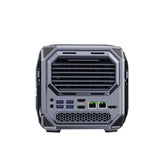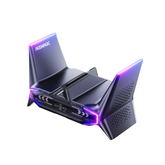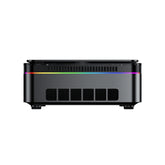What Is PCI Express (PCIe) and PCIe Slot? A Comprehensive Overview

For users who frequently operate desktop computers and mini PCs, the term "PCIe" is likely a familiar one, as it commonly appears in the context of motherboards, graphics cards, and even storage devices like hard drives. Recognized as one of the most vital interfaces or channels within a computer, PCIe plays a significant role in system performance and expansion capabilities. Despite its importance, many people aren't quite sure what PCIe actually is or what functions it serves. There's a common misconception that it's exclusively used for plugging in graphics cards, but in reality, its applications are far more diverse. Today, let's take a closer look at this intriguing "PCIe" and uncover the breadth of its uses.
What is PCIe?
PCIe (Peripheral Component Interconnect Express) is a high-speed serial computer expansion bus standard proposed and promoted by Intel. It is designed to replace the older PCI, PCI-X, and AGP bus standards to achieve higher data transfer rates and simplify system design.
The predecessor of PCIe is PCI, which used parallel transmission methods and had numerous limitations. When the PCIe serial bus standard was introduced, it aimed to supersede the old PCI, PCI-X, and AGP standards for better data rates and simplified system architecture. After being certified and released by the PCI-SIG (PCI Special Interest Group), it was renamed "PCI Express," abbreviated as "PCIe."
PCIe Lanes and Slots
PCIe's flexible lane configurations are a key feature that allows it to meet varying bandwidth requirements of different devices. Lanes are the fundamental units of PCIe bandwidth, with common configurations including x1, x4, x8, and x16, where the number denotes the count of lanes bundled together. For instance, a PCIe x1 slot has a single lane suitable for lower-bandwidth devices like sound cards, while a PCIe x16 slot combines sixteen lanes to provide the high bandwidth necessary for graphics cards and other performance-intensive hardware. The number of lanes directly affects both the data transfer rate and the physical size of the slot, enabling system designers to balance space, cost, and performance effectively.
How Do PCIe Slots Work?
PCI Express (PCIe) slots are connectors on a computer's motherboard that allow for the attachment of expansion cards, such as graphics cards, solid-state drives (SSDs), and network interface cards (NICs). PCIe slots work by providing high-speed, point-to-point serial connections between the motherboard and the installed devices.

PCIe slots come in different sizes, corresponding to the number of data lanes they support. The most common slot sizes are:
- PCIe x1: Supports one data lane
- PCIe x4: Supports four data lanes
- PCIe x8: Supports eight data lanes
- PCIe x16: Supports sixteen data lanes
Each PCIe slot has a specific number of data lanes (denoted as x1, x4, x8, x16, etc.), which are pairs of wires that transmit and receive data. The number of lanes determines the bandwidth of the slot—the more lanes, the higher the data transfer capability. When a device is inserted into a PCIe slot, the system performs a negotiation process to establish the highest supported PCIe version and the number of lanes for communication.
Why does PCIe have different lengths?
The bus bandwidth of PCIe interfaces is divided according to length into PCIe x1, PCIe x2, PCIe x4, PCIe x8, and PCIe x16. Although we can insert PCIe devices of any length into slots like PCIe x1 or PCIe x16 for operation, this obviously leads to a problem: devices that require low bandwidth will waste the excessive bandwidth of a PCIe x16 slot, while devices that require high bandwidth will be "underfed" in a PCIe x1 slot.

What are the functions of PCIe?
Data Transfer Mechanisms
One of PCIe's standout features is its ability to support full-duplex communication, meaning data can be sent and received simultaneously between the host system and connected devices. This is achieved through its serial lane architecture, where each lane consists of separate pairs of wires for transmitting and receiving data. Full-duplex capability effectively doubles the potential data throughput compared to half-duplex systems and reduces wait times for data exchange. This is particularly beneficial in scenarios where devices need to constantly send and receive data, such as in high-speed networking or real-time data processing applications.
Scalability
PCIe's design inherently supports scalability, allowing system performance to be adjusted by varying the number of lanes allocated to each device. If a device requires more bandwidth, it can utilize a PCIe slot with more lanes, such as upgrading from x4 to x8 or x16 as needed. This scalability extends to system upgrades and expansions, providing flexibility for future enhancements without necessitating a complete overhaul of the system architecture. The modular nature of PCIe lanes enables efficient use of motherboard space and resources, accommodating a wide range of devices with different performance requirements within the same system.
Quality of Service (QoS) Features
PCIe incorporates Quality of Service features to manage and prioritize data traffic effectively. Through QoS, PCIe can assign different priority levels to various data streams, ensuring that critical data receives the necessary bandwidth and low latency it requires. This is crucial for applications like streaming media, online gaming, or real-time communication, where delays or data loss can significantly impact user experience. Additionally, PCIe supports isochronous data transfers, which guarantee consistent data flow rates for time-sensitive information, further enhancing its suitability for multimedia applications and systems that require synchronized data delivery.
Versions and Bandwidth
PCIe 1.x to PCIe 5.0
Since its inception, PCIe has evolved through several versions, with each new iteration doubling the bandwidth per lane and introducing improvements in efficiency and functionality.
-
PCIe 1.x: The original version offered a data rate of 2.5 gigatransfers per second (GT/s) per lane, providing a bandwidth of approximately 250 MB/s.
-
PCIe 2.x: This version doubled the transfer rate to 5 GT/s per lane, increasing the bandwidth to about 500 MB/s.
-
PCIe 3.x: Further enhancements raised the transfer rate to 8 GT/s per lane. With improvements in encoding efficiency, it achieved approximately 1 GB/s per lane.
-
PCIe 4.0: Continuing the trend, PCIe 4.0 doubled the transfer rate again to 16 GT/s per lane, offering around 2 GB/s per lane.
-
PCIe 5.0: The latest ratified version pushes the transfer rate to 32 GT/s per lane, delivering a significant bandwidth of approximately 4 GB/s per lane.
Each version not only increases speed but also includes optimizations in signal integrity, power efficiency, and error correction capabilities. These advancements ensure that PCIe remains capable of meeting the demands of emerging technologies and high-performance applications.
Upcoming PCIe 6.0
PCIe 6.0 is set to be a substantial leap forward, with expectations to double the bandwidth per lane once more to 64 GT/s, equating to about 8 GB/s per lane. To achieve these higher data rates, PCIe 6.0 introduces Pulse Amplitude Modulation with four levels (PAM4) signaling. PAM4 increases the amount of data transmitted per signal change by encoding two bits per symbol, effectively enhancing data throughput without requiring a proportional increase in signal frequency. This advancement addresses challenges associated with signal integrity at higher frequencies. PCIe 6.0 will also incorporate improved Forward Error Correction (FEC) and updated protocols to maintain reliability and efficiency as data rates escalate, preparing the standard to support future innovations in data-intensive fields such as artificial intelligence, machine learning, and high-speed networking.
Extended reading: PCI Express 6.0 Specification
Importance of PCIe in Computer Systems
Performance Enhancements
PCIe plays a crucial role in elevating the performance of modern computer systems by substantially improving data transfer rates between the motherboard and connected devices. By providing a high-speed, point-to-point connection, PCIe minimizes bottlenecks that were prevalent in older bus architectures. This means that components like graphics cards, solid-state drives (SSDs), and network interface cards can communicate with the CPU and memory at much faster speeds. The increased bandwidth allows for quicker data retrieval and processing, which directly impacts system responsiveness. Users experience smoother multitasking, faster application load times, and enhanced overall efficiency, especially in data-intensive tasks such as gaming, 3D rendering, and large-scale computational simulations.
The enhanced data transfer capabilities of PCIe contribute to reducing latency and improving the throughput of the system. With faster communication channels, components can operate at their full potential without being limited by the transfer medium. This optimization ensures that high-performance hardware investments yield tangible benefits, leading to more efficient workflows and a better user experience. The scalability of PCIe also means that as demands increase, systems can be upgraded to support higher data rates without a complete overhaul, ensuring sustained performance improvements over time.
Versatility and Compatibility
One of the standout features of PCIe is its exceptional versatility and broad compatibility with a wide range of hardware devices. Whether it's high-end GPUs for intensive graphic processing, lightning-fast NVMe SSDs for rapid data storage and retrieval, or advanced network cards for high-speed connectivity, PCIe serves as the universal interface that brings these components together seamlessly. This versatility simplifies the process of customizing and upgrading computer systems, allowing users to tailor their setups to specific needs without worrying about interface limitations.
Moreover, PCIe is designed with backward and forward compatibility in mind. This means that newer PCIe devices can often operate in older slots, and older devices can be accommodated on newer motherboards. While the maximum performance is dictated by the lowest common version between the slot and the device, this compatibility ensures that users can upgrade components incrementally. It protects investments by allowing for gradual system enhancements rather than necessitating complete replacements. This flexibility not only extends the lifespan of existing hardware but also eases the transition to newer technologies as they become available.
Power Efficiency
In addition to performance and versatility, PCIe offers significant improvements in power efficiency over older interface standards. It incorporates advanced power management features that intelligently adjust power consumption based on the activity level of connected devices. For example, when a device is idle or under low load, PCIe can reduce power delivery to that component, minimizing unnecessary energy usage and heat generation. This dynamic power scaling contributes to lower overall power consumption, making systems more energy-efficient and cost-effective to operate.
The lower power requirements of PCIe also have broader implications for system design and sustainability. Reduced energy consumption leads to less heat production, which in turn can lessen the reliance on extensive cooling solutions. This not only makes for quieter and more compact systems but also enhances the longevity of components by mitigating thermal stress. As energy efficiency becomes an increasingly important consideration in both consumer and enterprise computing environments, PCIe's power management capabilities position it as a forward-thinking standard that aligns performance with environmental responsibility.
What can be plugged into a PCIe slot?
Graphics Cards
Graphics cards are among the most significant beneficiaries of PCIe technology due to their need for rapid data transfer to render high-resolution graphics efficiently. PCIe provides the necessary high-bandwidth connection between the GPU and the rest of the system, enabling smooth performance in graphics-intensive tasks such as gaming, 3D rendering, and video editing. This swift communication ensures that large amounts of graphical data are processed without bottlenecks, resulting in fluid visuals and responsive gameplay. Additionally, PCIe supports multi-GPU configurations through technologies like NVIDIA's SLI and AMD's CrossFire, where multiple graphics cards work in tandem to boost rendering power. By leveraging PCIe slots for these setups, users can achieve enhanced graphics performance, higher frame rates, and improved visual effects by effectively combining the capabilities of several GPUs within a single system.
Solid-State Drives (SSDs)
Solid-State Drives have seen remarkable performance advancements by utilizing PCIe, especially with the introduction of NVMe (Non-Volatile Memory Express) technology. NVMe SSDs connect directly to PCIe lanes, allowing them to bypass the slower SATA interface traditionally used for storage devices. This direct connection enables significantly faster data read and write speeds, drastically reducing boot times and speeding up file transfers. PCIe-based NVMe SSDs can achieve multiple gigabytes per second in data throughput, outperforming SATA-based SSDs by a wide margin. For users, this means applications load quicker, system responsiveness is heightened, and overall computing experiences are greatly enhanced. The integration of PCIe in SSDs has been a game-changer for data-intensive tasks and has become the standard for high-performance storage solutions in modern computers.
Network Interface Cards (NICs)
Network Interface Cards leverage PCIe to facilitate high-speed networking capabilities essential for contemporary connectivity demands. As network infrastructures advance to support speeds of 10 Gigabit Ethernet (10GbE), 25GbE, 40GbE, and even higher, the need for a robust interface like PCIe becomes critical. By using PCIe slots, NICs can handle these immense data transfer rates with the low latency required for efficient network communication. This is particularly important in servers and data centers, where vast amounts of data are transmitted and received continuously. PCIe's high bandwidth ensures that network operations do not become a performance bottleneck, allowing for faster data processing, improved server responsiveness, and smoother operation of cloud services and enterprise applications that rely on swift and reliable network connections.
Other Expansion Cards
Beyond graphics and storage, PCIe supports a diverse array of expansion cards that enhance system functionality and cater to specific user needs. Sound cards connected via PCIe can offer superior audio quality and processing capabilities compared to onboard audio solutions, benefiting audiophiles and professionals in music production. USB expansion cards plugged into PCIe slots can add more ports or newer USB standards to a system, increasing connectivity options for peripherals. In professional and industrial contexts, specialized PCIe cards are employed in equipment like data acquisition systems, where they interface with sensors and instruments to collect, process, and analyze data in real-time. These applications highlight PCIe's versatility in accommodating various hardware enhancements, making it a foundational component for both consumer PCs and specialized workstations that require additional or advanced functionalities.
PCI vs. PCIe
Overview of PCI
Peripheral Component Interconnect (PCI) is a hardware standard developed in the early 1990s that enabled the addition of peripheral devices to a computer's motherboard. Widely used in earlier computer systems, PCI provided a common interface for connecting components such as sound cards, network adapters, and graphics cards, facilitating greater customization and expansion of desktop PCs. The architecture of PCI is based on parallel bus communication, where multiple bits of data are transmitted simultaneously across several wires. This parallel approach operates on a shared bus topology, meaning all connected devices share the same communication pathway to the CPU and system memory. While innovative at the time, this design introduced limitations in bandwidth and scalability, as the shared bus could become a bottleneck when multiple devices demanded data transfer simultaneously.
Comparison Between PCI and PCIe
Comparing PCI to its successor, PCI Express (PCIe), reveals significant technological advancements that address the limitations of the older standard. One of the primary differences lies in data transfer rates; PCI's bandwidth is substantially lower than that of PCIe, making it less capable of handling the high-speed requirements of modern peripherals. In terms of communication methods, PCI uses parallel transmission, which can suffer from signal degradation and timing issues at higher speeds, whereas PCIe employs high-speed serial communication that transmits data sequentially with greater reliability. Additionally, PCI utilizes a shared bus topology where devices contend for bandwidth on the same path, while PCIe features a point-to-point topology that provides dedicated lanes for each connected device, eliminating competition for bandwidth. Physically, PCIe slots are designed differently to accommodate these changes, often being smaller and more energy-efficient, with improved power consumption profiles. The scalability and flexibility of PCIe also surpass PCI, as PCIe supports various lane configurations (such as x1, x4, x8, x16), allowing for performance scaling according to the needs of each device.
Advancements of PCIe over PCI
PCIe represents a significant leap forward from PCI, primarily through increased bandwidth and efficiency that align with the demands of modern computing. By utilizing serial communication and scalable lanes, PCIe can meet the high data transfer requirements of contemporary devices like advanced graphics cards and fast solid-state drives. The architecture enhances error handling and data integrity with improved protocols that ensure reliable transmission, reducing the likelihood of data corruption. Furthermore, PCIe introduces support for hot-plugging, enabling users to add or remove devices without shutting down the system—a feature particularly valuable in servers and systems requiring high availability. These advancements collectively make PCIe a more robust, flexible, and efficient interface compared to PCI, providing the necessary foundation for current and future technological developments.
Conclusion
PCIe is an indispensable high-speed expansion bus standard in modern computer systems, significantly enhancing data transfer rates and system performance by connecting high-performance components such as GPUs, CPUs, and solid-state drives. With the growing demand for high bandwidth and low latency in applications like artificial intelligence, machine learning, and big data, PCIe continues to drive advancements in computing technology. Currently, mainstream applications focus on PCIe 3.0 and 4.0, but PCIe 5.0 is gradually being adopted in data centers and new hardware. Future iterations, PCIe 6.0 and 7.0, will further unleash hardware potential. ACEMAGIC's mini PCs are equipped with PCIe interfaces, meeting users' needs for performance and expandability. We welcome you to choose ACEMAGIC for your computing needs.







Leave a comment
Please note, comments need to be approved before they are published.